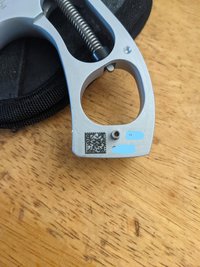-
If you enjoy the forum please consider supporting it by signing up for a NES Membership The benefits pay for the membership many times over.
You are using an out of date browser. It may not display this or other websites correctly.
You should upgrade or use an alternative browser.
You should upgrade or use an alternative browser.
Is this a microchip on my 642?
- Thread starter mousegunfan
- Start date
PLACE THE GUN INTO A FARADAY BAG. TOSS THE BAG INTO A DUMPSTER. SCORCH OFF YOUR FINGERPRINTS. WALK AWAY AND CHANGE YOUR NAME.
Nah. Probably just a tracking code they used at the factory. Like the assembly numbers.
Nah. Probably just a tracking code they used at the factory. Like the assembly numbers.
Why the raised etching if all it needs to do is make it out of S&W to the distributor and not last that long?manufacturing code. It can be scanned to determine S/N, origin, date, etc
I can think of a few reasons.Why the raised etching if all it needs to do is make it out of S&W to the distributor and not last that long?
1 is if you returned it for warranty repair they would know everything they need to.
2 is a 'backup/second' serial number that the vast majority of folks wouldn't know about. In case the first one was destroyed.
3 is tracking during manufacturing. Perhaps before it is serialized. It's a lot easier for a computer to read a code like this than an engraved serial number.
sorry bro your gun is having a herpes outbreak. don't touch your junk without washing your hands first. treat it with abreva, put the pink grips back on, and put it back in your wife's purse where it belongs
Use your phone to scan it.....it will probably bring you to a website for warranty info or owners manual info.I took off the grips and see this. It's raised. You can feel the roughness.

QR code - Wikipedia
D
Deleted member 67409
I can think of a few reasons.
1 is if you returned it for warranty repair they would know everything they need to.
2 is a 'backup/second' serial number that the vast majority of folks wouldn't know about. In case the first one was destroyed.
3 is tracking during manufacturing. Perhaps before it is serialized. It's a lot easier for a computer to read a code like this than an engraved serial number.
The last thing that happens to a "firearm" during production is that its serialized. Until then, the gun has no serial number. QR codes serve an inventory control purpose. S&W likely doesn't use the gun's bound-book serial number, anyways, for internal purposes - hence the QR code. S&W makes thousands of guns per month, imagine having to have employees type in seven, eight, nine, ten digit long serial numbers all day for internal tracking... or just beep a QR code. The QR code is more efficient.
The Army started using qr codes in the arms room awhile ago. Weapons and sensitive items are issued out with a scanner......Scan the code on the rifle.....scan the code on the Soldiers ID card......hit enter on the laptop. You just issued a weapon. Way faster than the sign in/out roster.The last thing that happens to a "firearm" during production is that its serialized. Until then, the gun has no serial number. QR codes serve an inventory control purpose. S&W likely doesn't use the gun's bound-book serial number, anyways, for internal purposes - hence the QR code. S&W makes thousands of guns per month, imagine having to have employees type in seven, eight, nine, ten digit long serial numbers all day for internal tracking... or just beep a QR code. The QR code is more efficient.
AHM
NES Member
@strangenh delivers.datamatrix code
[)>{RS}06{GS}17V55358{GS}1P215800000{GS}SDNM3202{RS}{EOT}
Probably contains all you covered up and more.
F that noise.PLACE THE GUN INTO A FARADAY BAG. TOSS THE BAG INTO A DUMPSTER.SCORCHSTORCH OFF YOUR FINGERPRINTS. WALK AWAY AND CHANGE YOUR NAME.
Don't settle for half measures.

Holding out for reports of blinking blue lights in pine trees.Nah. Probably just a tracking code they used at the factory. Like the assembly numbers.
ISOTOX
NES Member
- Joined
- Feb 20, 2008
- Messages
- 8,260
- Likes
- 5,329
Share:
Similar threads
- Replies
- 8
- Views
- 378


